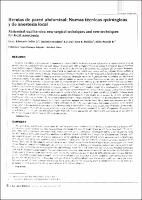Hernias de pared abdominal: Nuevas técnicas quirúrgicas y de anestesia local
Date
1999Author(s)
Dedios O., Edmundo
Mendoza, Rudorico
Ruidías, Rosa E.
Aranda B., Elida
Metadata
Show full item recordAlternate title
Abdominal wall hernias: new surgical techniques and new techniques for local anesthesia
Abstract
Mediante este trabajo se demuestra que el tratamiento quirúrgico ideal de las hernias de pared abdominal es el reforzamiento de la pared posterior, con o sin prótesis y bajo anestesia local. Durante 19 meses (abril 1995 a octubre 1996). en el Servicio de Cirugía de Día del Policlínica "Jorge Reátegui Delgado", EsSalud, Piura, se operó a 182 pacientes (96 hombres y 86 mujeres), encontrándose 203 patologías herniarias. utilizándose en el 60% anestesia local (anestesia epidural para las grandes hernias, eventraciones, hernias recidivas y algunas hernias múltiples y anestesia general en niño es menores de 14 años, en dos pacientes mujeres por problemas con la 0TB (obturación tubaria bilateral) adicional. A lo largo de este trabajo hemos variado la técnica para hernias umbilicales. Afrontamos sin tensión la pared posterior, reforzándola con injerto de la aponeurosis anterior o con malla tipo Marlex. Se ha cambiado también el material de sutura llegando a utilizar nylon de pescar en pared posterior, en el 100% de pacientes, en la segunda mitad del presente estudio. Nuestra tendencia a usar anestesia local ha sido cada vez mayor hasta llegar a ser rutinaria. Hemos preferido para la gente joven, la técnica de Shouldice en 2 o 3 planos, con nylon de pescar y la técnica de Robbins y Liechtenstein para hernias recidivas en pacientes mayores de 45 años o con debilidad dudada de la pared posterior Las hernias de Spiegel Y crurales femoral. han sido operadas con malla tipo Marlex, siempre preperitoneal, en las primeras hernias crurales hemos usado la técnica de Shouldice Se encontró dos recidivas al principio de nuestro trabajo, en un joven de 22 años, operado con Shouldice, habiendo usado vicryl en lugar de nylon en una hernia inquino-escrotal gigante por deslizamiento y otra recidiva en un paciente de 53 años, operado con Shouldice en 3 planos y con Dexon 2,0. No se reoperó inmediatamente a ningún paciente: se registró 5% de complicaciones menores, tipo seromas, hemalomas e infecciones pequeñas de las heridas operatorias, ninguna complicación mayor No se presentaron reacciones al nylon o 111alla tipo Marlex, pero sí dos casos de alergias al acrílico usado para piel No hubo ningún fallecimiento, el porcentaje de recidivas es 1 % en total, sie11do a111bas en hernias inguinales operadas a lo Shouldice y con suturas reabsorbibles. Si sólo se toma en cuenta las 97 hernias inguinocrurales, las recidivas están en 2% en hernias inguinocrurales, con un control mínimo de 13 meses y máximo de 33 meses. El seguimiento de los pacientes se ha logrado en un 71 %, por visita personal del cirujano al domicilio de cada uno de ellos, por teléfono en 6% y por datos de los familiares en 4%. Se logró evaluar a 165 (81%) de las 203 patologías operadas. By means of this research work is demonstrated that ideal surgical treatment of abdominal wall hernias is reinforcement of of posterior wall, with or without use of a prothesis, and under local anesthesia. 182 patients (96 male, 86 female) showed up 203 hernias, from April 1995 to October 1996. 60% of these hernias were repaired under epidural anesthesia in adults and general anesthesia for children under 14 years old. Only two adult umbilical hernia cases received local anesthesia and additional general anesthesia due to complication of bilateral tubal blockade. With this research Mayo technique was not used and instead of it a simple confronting of posterior wall with anterior aponeurosis graft or Marlex-type mesh was used. Aldo fishing nylon replaced sutures of posterior wall in all patients. There was a trend far the routine use of local anesthesia for all hernias. Bassini and Mc Vay techniques were abandoned far repair of inguinocrural hernias because of higher tension considerations and instead of it the Shouldice technique with fishing nylon was used in young patients and the Robbins and Lichtenstein technique was used in patients older than 45 years, recurrent hernias or suspected posterior wall weakening. Spiegel and crural hernias were repaired with pre peritoneal Marlex-type mesh and the Shouldice surgical technique. Two cases of hernia recurrence were found, one in a 22 years old male using Shouldice technique and Vicryl instead of Nylon far a giant inguinoscrotal hernia and the other recurrence was in a 53 years old male using Shouldice technique and Dex
On2/0. No patient was immediately reoperated 5% of minor complications were found such as seroma, hematoma, slight surgical wound infection. No reactions to fishing nylon or Malex-type mesh were observed. Two dermal allergies were observed when acrylic was used inskin suture. Zero immortality, and 1% hernia recurrence were observed. Follow up was done in 71% of cases by means of patient home visit, 6% by phone, 4% by relatives interview accomplishing 81 % of overall follow up of the 203 repaired hernia.
Collections
- 1999 [20]






